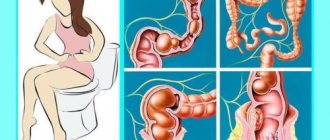Esophagogastroduodenoscopy and gastroscopy - what is the difference?
EGDS is a method of visual examination of the walls of the esophagus, stomach, and duodenum.
Makes it possible to diagnose most diseases in the early stages and allows you to visualize the clinical picture of diseases. It is also possible to conduct histological and cytological examinations, the results of which become known after approximately 5-7 minutes. During the procedure, material is collected for this study.
The duration of the procedure is 10-20 minutes; standard preparation is required, which includes following a diet and drinking regimen. You should not consume food or water 8 hours before the test. It must be remembered that the procedure has its contraindications, so the doctor needs to talk about the presence of concomitant diseases and the use of medications.
The essence of the procedure is to insert a tiny device containing a sensor into the esophagus. The signals from it are converted into an image on the monitor screen.
A big plus is the ability to diagnose cancer in the early stages, which allows for timely treatment. According to statistics, approximately 80% of cancer patients learn about their disease only in the later stages.
With the help of endoscopy and gastroscopy, in 99% of cases it is possible to diagnose cancer at an early stage, or at the stage of the onset of a cancerous tumor. Also, using this study, you can test for lactase deficiency and determine Helicobacter pylori.
Esophagogastroduodenoscopy (EGDS) and gastroscopy are diagnostic methods belonging to the group of endoscopic examinations. Both procedures are performed using a gastroscope.
What is the difference between them?
The main difference between endoscopy and gastroscopy in the examined organs. In the case of esophagogastroduodenoscopy, the entire area of the gastrointestinal tract (gastrointestinal tract) is examined: duodenum, stomach, esophagus. During a gastroscopy, only the stomach is checked. Accordingly, this procedure is prescribed to patients who are highly likely to develop pathology in this organ.
How often can a gastroscopy procedure be performed?
Gastroscopy is one of the most informative methods for studying the condition of the gastrointestinal tract (its upper section), since this procedure allows you to visually assess the presence of damage to the gastric mucosa, the presence of polyps, erosions, ulcers, bleeding and other pathologies of the walls of the stomach and duodenum. Many patients are interested in the question of how safe this generally unpleasant procedure is, and how often gastroscopy can be done in the presence of various pathologies of the digestive tract.
However, this study is also prescribed for many other diseases. For example, cardiovascular: before performing a coronography, an endovascular cardiologist must ensure that there are no gastric erosions or ulcers. Otherwise, the operation will be postponed, since the patient on the eve of surgery must take strong antithrombotic drugs that thin the blood and promote bleeding.
For what diseases is gastroscopy prescribed?
A diagnostic procedure is prescribed if any disease is suspected or as an additional diagnostic method when there is not enough information about the patient’s health status.
Diseases that can be identified during the study:
- tumors (both malignant and benign). In this case, doctors can additionally take a tissue sample for further study;
- chronic gastritis;
- obstruction of the esophagus;
- stomach or duodenal ulcer;
- esophageal diverticula;
- chronic eating disorder;
- inflammation of the mucous membrane of the esophagus, duodenum and stomach;
- reflux of semi-digested food from the stomach into the esophagus.
Clinical manifestations of certain diseases may be similar, so it is difficult to immediately determine the causes and, in fact, the disease. Gastroscopy is prescribed based on the patient’s complaints.
These include:
- stomach ache;
- constant heartburn and belching;
- sour taste in mouth in the morning;
- bloating, regardless of the severity of food consumed;
- urge to vomit;
- sudden weight loss for no obvious reason;
- bitterness in the mouth.
When should you do research?
Endoscopy is prescribed in many cases; it is an informative method that makes it possible to timely diagnose diseases that are dangerous to life and health. Indications have a wide range - these are:
- nausea, frequent vomiting;
- difficulty eating;
- pain of various types in the stomach area;
- presence of symptoms of gastric bleeding;
- check to evaluate the ongoing treatment of the gastrointestinal tract;
- suspicion of the presence of cancer of the esophagus, stomach or duodenum.
A child may be prescribed this procedure for pain or if foreign bodies enter the stomach.
Contraindications
General symptoms such as nausea, diarrhea, vomiting do not always indicate the presence of diseases of the digestive tract, but if the patient complains, he will most likely be prescribed a series of tests that should confirm or refute suspicions of gastritis, duodenitis or other gastric pathologies.
Other indications for prescribing gastroscopy include the following:
- suspicion of the presence of malignant neoplasms in the stomach/esophagus;
- the need for constant monitoring of the condition of the gastric epithelium in the treatment of gastrointestinal diseases;
- symptoms of gastric bleeding;
- if a foreign object enters the stomach;
- if the patient often experiences pain in the epigastric region;
- difficulties experienced by the patient when eating;
- to clarify the diagnosis for a number of diseases not related to gastrointestinal pathologies.
FGDS should be prescribed with caution to children under six years of age, if there is a history of severe mental disorders, if the patient is diagnosed with exacerbation of chronic gastritis or gastric ulcer, or if there is a respiratory tract infection.
In any case, the appointment of this procedure can occur repeatedly, and not knowing in what cases and how often gastroscopy of the stomach can be done is very worrying for many patients.
As for contraindications to the appointment of esophagogastroduodenoscopy (the official medical name for gastroscopy), there are few of them:
- some heart diseases;
- narrow compared to the standard entrance to the stomach;
- obesity 2 – 3 degrees;
- hypertension;
- kyphosis/scoliosis;
- a history of stroke/heart attack;
- congenital/acquired blood diseases.
The doctor may refer the patient for gastroscopy if he has symptoms of stomach pathologies or primary signs of internal bleeding. The procedure is also carried out to clarify the results of other tests (ultrasound, x-ray). For what symptoms is gastroscopy of the stomach performed?
Main indications for the procedure:
- lack of appetite, severe weight loss, low level of hemoglobin in the blood (suspicion of cancer);
- nausea, heartburn, frequent abdominal pain, vomiting (symptoms indicating the development of gastric pathologies);
- melena (black semi-liquid stool), vomiting with blood, dizziness, loss of consciousness (symptoms of internal bleeding);
- prolonged constipation (more than 3-4 days) coupled with nausea, pain in the upper abdomen.
Contraindications for the procedure are quite vague. Especially if it is carried out on an emergency basis. Patients with internal bleeding undergo gastroscopy regardless of whether they are at risk for complications or not.
General contraindications:
- acute myocardial infarction;
- mental disorders, increased nervousness, mania;
- respiratory failure (in severe form);
- hypertensive crisis;
- cerebrovascular accident (acute).
Gastroscopy is an examination of the upper organs of the gastrointestinal tract using a gastroscope inserted through the mouth of the subject. Gastroscopy shows the condition of the duodenum, stomach and esophagus. This is necessary if you suspect the following pathological processes:
- damage to the duodenal mucosa;
- inflammation of the gastric mucosa;
- diseases of the esophagus, accompanied by inflammation of its mucosa;
- peptic ulcer of the stomach or duodenum;
- suspicion of bleeding in any of the upper organs of the digestive tract;
- suspicion of cancer.
If the examination is routine, then the following contraindications for gastroscopy can be identified: serious disturbances in the functioning of the respiratory system, an emergency condition caused by a persistent increase in blood pressure, heart rhythm disturbances, serious disturbances in the functioning of the cardiovascular system.
The list continues with acute disruption of blood flow through the vessels of the brain, expansion of the aorta due to a pathological change in connective tissue structures, damage to the heart muscle caused by an acute disruption of its blood supply.
The recovery period after a previous severe form of myocardial infarction or stroke and severe forms of mental illness are additional contraindications.
Is it painful to do FGDS or not?
In modern medicine, various methods are used to diagnose diseases of the digestive organs.
One of them is fibrogastroduodenoscopy. The question: “What kind of procedure is this?” – asks every person who has received a referral for this examination. FGDS is an informative and very accurate technique for studying the mucous membranes of the digestive tract - the esophagus, the upper part of the duodenum, and the stomach. When performing it, a special optical device is used - an endoscope.
This medical instrument looks like a flexible thin tube (about 1 centimeter in diameter). Inside there is a channel for introducing devices for collecting samples of biological material for analysis, and there are also thin optical fibers that supply lighting and transmit video images.
For many patients, the upcoming procedure causes panic.
By their incorrect behavior during the examination, they make this diagnostic and therapeutic manipulation very uncomfortable for themselves.
In our article we will tell you when endoscopy is performed and how the patient needs to prepare for the examination in order to easily endure it. We will also give an answer to the question of whether it is painful to do FGDS.
Indications for the procedure
Practicing gastroenterologists recommend diagnosing the organs of the digestive system for preventive purposes, because any pathological process is easier to cure at an early stage of development. The need for examination arises when preparing for abdominal (abdominal) surgery and the following clinical signs appear in the patient:
- frequent abdominal pain of unknown etiology and different nature;
- feelings of heaviness and discomfort in the digestive tract;
- frequent heartburn;
- nausea of unknown origin;
- regular vomiting streaked with blood;
- unpleasant belching;
- dysphagia – problems with swallowing;
- appetite disorders;
- decrease in hemoglobin level in the blood;
- weight loss.
These symptoms are an alarming signal for the development of diseases of the pancreas, liver, and gall bladder.
With the help of FGDS, you can remove foreign bodies from the intestine, remove benign tumors, administer medications, perform a biopsy, perform electrocoagulation, or apply a ligature to a bleeding vessel.
Carrying out fibrogastroscopy (FGS) - examination of the stomach, recommended for suspected peptic ulcers, gastritis, the presence of foreign objects in the organ (coins, buttons, balls), the formation of a benign neoplasm (polyp) or a malignant tumor
Preparation rules
In many clinics, along with a referral for examination, the patient is always given a brochure that describes in detail the plan of preparatory measures. These recommendations are worth following - it depends on whether the sensations during the procedure will be very painful or not.
On the eve of the FGDS, the patient needs:
Sore throat after FGDS
- do not drink or eat 12 hours before the procedure;
- dinner should consist of foods that are easily digestible and do not irritate the mucous membrane;
- do not eat spicy, pickled and highly salted foods - they cause irritation of the mucous walls of organs, which reduces the accuracy of diagnosis;
- two days before the procedure, exclude chocolate and nuts from the diet - they can linger in the folds of the mucous membranes and complicate the examination;
- do not take medications if necessary - it is better to take the morning medication by injection;
- refrain from smoking - this bad habit contributes to nervousness and involuntary muscle contractions;
- get rid of the feeling of fear, since a negative attitude provokes tension in the muscles of the esophagus - this makes it difficult to insert the endoscopic device;
- know that drooling and belching during the procedure are normal, and medical professionals will conduct the examination as quickly as possible and with minimal discomfort.
Patients are particularly concerned about the biopsy, but this procedure is performed under local anesthesia and there are no consequences after its completion.
Before starting the procedure, the specialist who will carry out the diagnosis will tell the patient in detail about the procedure and possible complications.
In modern medical centers, patients are taught proper breathing techniques several days before FGDS. Knowing the basics of proper breathing will help make the examination minimally unpleasant.
You need to breathe as follows: inhale and exhale through your nose only (if you try to inhale through your mouth, saliva can get into the respiratory tract and cause a cough). Breathing should be slow and deep (short sharp inhalations and exhalations disrupt the process of inserting the probe, which will lead to injury to the esophagus).
Conclusion
A completely painless procedure is possible only in a state of medicated sleep. However, if the patient behaves correctly, a qualified specialist will insert endoscopic equipment through a special “mouthpiece”, which will prevent reflex clenching of the teeth. The patient will have to endure only one unpleasant moment - when the gastroscope tube presses on the root of the tongue.
With uniform breathing, the gag reflex provoked by this action quickly disappears; in the future, only the presence of a foreign body in the digestive tract is felt. Correct behavior of the patient helps the doctor conduct the examination as quickly as possible and eliminates the likelihood of complications.
Source: https://apkhleb.ru/endoskopiya/bolno-delat-fgsd-net
After the procedure
To achieve the most effective results from diagnostics, you need to know how to comply with important requirements. So, the patient should properly prepare for the procedure. According to medical statistics, about 2% of patients are prepared for the study in bad faith, which leads to incorrect or insufficiently informative results.
After the patient has undergone an endoscopic procedure, he is prohibited from eating food for two hours. You can start eating only after the discomfort has stopped. If a specialist took a biopsy, in this case you should not eat hot foods for a couple of days.
If you are expecting a gastroscopy, your attending physician will tell you how to prepare for it, who will also familiarize you with all the nuances of the procedure and possible complications. The patient must take the upcoming study seriously.
Complications after gastroscopy are not that common. This depends on a number of factors:
- individual characteristics of the patient’s body;
- doctor's qualifications;
- accuracy in the actions of a specialist;
- correct adherence to all recommendations before, during and after gastroscopy;
- a list of procedures performed on the patient;
- the presence of diseases that the subject was silent about;
- an allergy to an anesthetic that was not disclosed by the patient or that was not checked by the physician before the examination.
When performing a gastroscopy for diagnostic purposes, an experienced doctor only needs 12 to 15 minutes to examine the entire inner surface of the stomach, however, in some cases, a biopsy (taking a sample of epithelial tissue for laboratory testing) or other therapeutic manipulations (for example, administering medications) may be necessary.
Such a comprehensive study can last up to 25–40 minutes.
For some time after the manipulation, the patient should be in a supine position; eating during gastroscopy without a biopsy is allowed after 60 minutes. If the procedure was carried out with a biopsy taken, the first meal of non-hot food is allowed after 180 - 240 minutes.
If the procedure is performed on a child under 6 years of age or a patient with a history of mental disorders, gastroscopy can be performed under general anesthesia.
In medical institutions, a special room must be equipped for conducting FGDS. The patient lies on the couch on his left side and bends his knees to his chest. There is a nurse nearby who calms and reassures the patient, while holding his hands so that he does not inadvertently knock over the device. Careless removal of the instrument can result in injury to internal organs.
A special mouth guard is inserted into the mouth to prevent damage to the device due to bites. Anesthesia is performed upon request or as prescribed by a doctor.
Then a gastroscope is inserted into the oral cavity or through the nose, which is a thin and flexible hose with a small camera at the end. Before doing this, you need to take a deep breath to widen the hole. During the procedure you need to breathe deeply, evenly and calmly.
The procedure takes no more than 20 minutes (if general anesthesia is used, it can take up to an hour - in this case, after the examination, the patient is taken to the ward until he wakes up).
The results of the study will be ready on the day of the study. If a piece of tissue was taken for a biopsy, the answer will come in 5-10 days.
Diagnostic testing is difficult for patients, especially from the psychological side. The procedure is somewhat unpleasant, but in order to make the doctor’s work easier, as well as significantly speed up the process and ease your condition, you need to prepare properly.
People feel fear when they see the tube and realize that they will have to swallow it. This is not surprising, because the gastroscope in the photo and in real life looks terrifying and even traumatic.
Gastroscopy can only be done if the patient has properly prepared for it:
- The procedure is carried out only on an empty stomach.
- The patient should not eat 8 hours before diagnosis.
- Before gastroscopy, you should not drink water and, especially, alcohol.
If the patient has dentures or removable teeth, he must remove them before the procedure, since such dental structures interfere with the passage of the gastroscope.
Before checking your stomach, you need to inform your doctor about all chronic and acute diseases, allergic reactions to certain drugs. This is necessary in order to avoid all sorts of complications after the procedure.
With the invention of visual examination methods, diagnostics entered a completely new level. The ability to see the problem with one’s own eyes gave doctors the key to making an accurate diagnosis and prescribing effective treatment.
Gastroscopy, or esophagogastroduodenoscopy, since its introduction into clinical practice and to this day remains the most popular and informative method for diagnosing diseases of the esophagus, stomach and duodenum.
A stomach ulcer is the result of the fact that the patient ignored inflammatory processes in the gastrointestinal tract for a long time or treated them incorrectly. Peptic ulcer disease becomes the next stage after the appearance of gastritis and some other pathologies.
Therefore, it is very important to take timely care to avoid another round of exacerbations. Gastrointestinal diseases need to be treated systemically and comprehensively.
It is important to recognize the signs of a stomach ulcer in time, since the symptoms may coincide with signs of other gastrointestinal diseases. But what if the condition worsens? What are the signs of a stomach ulcer?
If a stomach ulcer develops, the symptoms and manifestations are quite characteristic of this disease. Also, in some cases, the disease is asymptomatic.
But most often, an ulcer has very specific and quite pronounced characteristic symptoms. They are the ones who should alert the patient.
This is a signal from the body that absolutely cannot be ignored. Despite the fact that an ulcer has characteristic symptoms, these symptoms may differ from patient to patient in their intensity and other characteristics.
It all depends on the degree of development and neglect of the disease, its form and localization of the inflammatory process. The longer the patient ignores the progressive pathology, the more pronounced its symptoms will be.
And in many cases, the ulcer is completely asymptomatic. This is the most difficult type of pathology development, since for a long time the patient may not be aware of the developing ulcer.
What symptoms should you be wary of? If an ulcer appears, the symptoms may vary. But the very first one is pain.
Already in the earliest phases of the development of the disease, pain is observed in the so-called abdominal region. But pain is also a symptom of other diseases, such as gastritis or pancreatitis.
How do you understand that it is a peptic ulcer? A characteristic feature of pain in this disease is that it comes when a person is hungry, or at night. This forces the patient to go get something to eat.
But this is not a 100% sign. In order to establish an accurate diagnosis, you will need to consult a gastroenterologist.
He will carefully record all complaints, clinical signs, prescribe tests and all kinds of studies.
The nature of the pain may indicate that it is a stomach ulcer that is developing. At the same time, the general condition of the body worsens, and other unpleasant subjective sensations appear.
A characteristic feature of a stomach ulcer is that it is always chronic. At the same time, the patient either suffers from another exacerbation, or goes into remission for a while.
It is typical that exacerbations occur quite often. But in order to achieve stable remission, comprehensive and competent drug treatment will be required.
In order to begin treatment of the disease at the earliest stages of its development, it is important to make an accurate diagnosis in time. Therefore, at the first symptoms, consult a doctor.
Only he can determine the exact cause of your suffering and help you overcome it as quickly as possible. A gastroenterologist is well aware of the symptoms of a stomach ulcer, signs that are important to immediately pay attention to.
The first symptoms that appear at the very beginning of the development of the disease are especially indicative for making a diagnosis. We will look in detail at what main symptoms can be used to determine that an ulcer is developing, and what accompanying signs may be.
We will also consider the symptoms of possible complications.
Stomach ulcer: signs
All the unpleasant symptoms of a stomach ulcer make themselves felt when it worsens. It has been noted that the peak of such exacerbations is seasonal.
It most often appears in autumn or spring. Why at this time? Doctors believe that the whole point is a decrease in the body's immune defense.
It is in autumn or spring that our body experiences a deficiency of vitamins and minerals. His protective powers are noticeably reduced.
During this period, exacerbations of chronic diseases, including ulcers, may occur.
Relapse of the disease is always unexpected and unpleasant. Its duration can vary - from a month to six.
This condition cannot be tolerated. After all, the development of an ulcer can significantly harm the entire gastrointestinal tract.
It ceases to perform its functions. But it is the gastrointestinal tract that provides us with the influx of much-needed fats, carbohydrates, proteins, microelements and vitamins.
If problems begin in it, then the intake of these substances into the body decreases sharply. The patient begins to lose weight, experiences pain, general weakness, his sleep is disturbed, and he becomes nervous.
To avoid this, you need to pay attention to alarming symptoms in time and contact an experienced specialist. Today, the level of development of gastroenterology allows us to successfully treat many forms of gastric ulcer.
The main thing is not to start this disease. If you ignore it, you can expect very dangerous symptoms.
In the most advanced cases, surgical intervention may be required.
During an exacerbation, the following symptoms may indicate the development of an ulcer:
- Localized and fairly intense pain appears in the upper abdomen.
- If the disease is advanced, the pain will be of a more uncertain localization.
- Quite well-defined dyspeptic symptoms are observed. The patient experiences nausea, diarrhea and vomiting may occur. The vomit may contain bile or blood.
- General health deteriorates significantly. The patient begins to get tired quickly and finds it difficult to carry out his daily activities. Headache may occur frequently.
- Brain disorders then develop. A severe migraine appears, and dizziness may occur. The patient develops apathy, consciousness acquires uncharacteristic inhibition.
- Every second patient experiences belching, heartburn, and an unpleasant odor can be felt from the mouth.
Let us immediately warn you that it is almost impossible to make this diagnosis on your own. These may be symptoms of gastritis and other gastrointestinal diseases. In order to dispel doubts, you will need the help of a doctor.
With peptic ulcers, many functions of the digestive organs are disrupted. Its development can be triggered by numerous reasons, for example,
- chronic inflammatory process,
- smoking,
- abuse of strong alcohol,
- influence of toxic substances,
- reflux,
- violation of the normal level of acidity, etc.
Over time, these negative factors form the characteristic symptoms of the disease. Belching and frequent heartburn often help identify this disease.
They are a characteristic symptom of an ulcer if they appear a couple of hours after eating. In this case, there are no painful sensations after the next meal.
Symptoms may also differ depending on what the patient eats.
In order for the doctor to correctly assess the mucous membrane of the gastrointestinal tract during the diagnostic process, the patient must first of all undergo good preparation before gastroscopy. The study is usually performed in the first half of the day, on an empty stomach. It is not recommended to eat food 6–8 hours before the scheduled examination. You can read more about the nuances of preparation in this article.
After gastroscopy, the patient is in a state reminiscent of alcohol intoxication for some time. He comes to his senses after 2-3 hours, when the sedatives stop working. And also, for some time, those who have undergone the study may experience the release of gases from the esophagus or stomach through the mouth and a feeling of fullness in the abdomen against the background of the remaining gases used to inflate the walls of the stomach.
Fgds hurts or not
For many patients, the upcoming procedure causes panic.
By their incorrect behavior during the examination, they make this diagnostic and therapeutic manipulation very uncomfortable for themselves.
In our article we will tell you when endoscopy is performed and how the patient needs to prepare for the examination in order to easily endure it. We will also give an answer to the question of whether it is painful to do FGDS.
When to do the test
The FGDS procedure is one of the most effective research methods in the field of gastroenterology. The need to undergo the procedure arises in case of the following indications:
- if you suspect a stomach or intestinal ulcer;
- if esophagitis is suspected;
- if there are suspicions of neoplasms in the digestive organs.
In case of frequent, constant or periodic complaints of stomach pain, as well as nausea, sour belching and defecation disorders, the doctor also prescribes the patient to undergo a gastrointestinal tract examination. But in addition to the study, drug treatment can also be carried out using gastroscopy. This treatment involves detecting and then stopping bleeding when an ulcer opens.
But that’s not all, because with the help of FGDS you can remove various foreign bodies from the gastrointestinal tract that have been eaten.
Most patients are simply afraid to undergo this examination, especially when they learn the details and features of its implementation. It’s normal to be afraid to undergo an FGDS, especially since the procedure is really not the most pleasant.
Only in order to promptly diagnose or eliminate serious diseases, you will need to decide on gastroscopy.
Is it painful to do FGDS?
Examination of the upper digestive tract can cause a lot of discomfort. A considerable proportion of patients who have personally experienced the sensations during gastroscopy assure that it does not hurt. At the same time, they note that FGDS is easier to tolerate if the doctor uses sedation or general anesthesia.
Good to know! Gastroenterologists prefer to use radical methods of pain relief only in extreme cases, when it is assumed that the patient will not be able to adequately tolerate the manipulations.
Discomfort during the procedure is caused by the gastroscope hose, which creates pressure on the root of the tongue. A certain amount of discomfort is caused by the air that the doctor supplies when advancing the tube of the device for better visualization. It can stretch the esophagus and stomach quite strongly, resulting in mild to moderate pain.
For patients who are especially worried about whether gastroscopy is painful or not, a preliminary explanatory conversation is held. In addition, the doctor has the right to conduct a number of tests aimed at establishing the boundaries of the pain threshold. If it is reduced, gastroscopy will be performed without pain under sedation or anesthesia.
Research procedure
The process begins with the patient signing a document stating that he agrees to undergo an FGDS. After this, the doctor tells you to take the appropriate position (gastroscopy is performed in a lying position on the left side), and then lubricates the oral cavity with a special solution. This is a local anesthesia that can reduce the development of vomiting.
When everything is ready, the doctor gives the patient a special ring on the teeth, which does not allow the mouth to be closed. An endoscope is inserted into this ring until the device reaches the desired target.
The doctor visually examines the condition of the stomach, intestines or esophagus, and then takes a sample of the mucous membrane. Stomach mucus is taken for analysis, which allows for more detailed examination and diagnosis.
The gastroscopy procedure is performed in a specially equipped room. It is worth noting that in frequent cases the probe is inserted through the mouth, but it can also be inserted through the nose.
After the procedure is completed, the doctor removes the probe, and this completes the entire process.
Is it possible to drink before gastroscopy?
The only liquid you can drink is pure still water. Tea, juice, coffee and compotes are prohibited. The appointment can be made at least 8 hours before gastroscopy.
You can drink little by little, for example, take a couple of sips if your mouth is dry. You are allowed to drink no more than 100 ml at a time. Liquids must be excluded 3 hours before the procedure.
It is allowed to take medications that cannot be skipped and those that are taken hourly.
What tests are needed?
If you do not have certain tests on hand, your doctor may refuse to test you. Therefore, it is better to take care and collect them in advance. If you are in a hospital, then everything will be done for you (as planned in the hospital). In other cases, you need to take the test yourself and bring the results to the doctor:
- clinical blood and urine analysis;
- biochemical blood test;
- HIV;
- for hepatitis B and C;
- blood type and Rh factor;
- ECG;
- coagulogram (a test that shows blood clotting).
If you have additional diseases (for example, asthma), a test for vital capacity (lung capacity) may be required.
In any case, before you go for tests, go for a consultation with your doctor. Some hospitals require a full list of tests, while others only need a few.
What is the FGDS procedure?
FGDS as a method for examining the stomach
The procedure is performed by an endoscopist in a specially designated room. Indications include various diseases of the stomach and esophagus, ulcers, erosions. In case of gastric bleeding, emergency FGDS is possible. The doctor may cancel the procedure due to severe damage to the tissue of the esophagus, burns or scarring of the tissue, that is, in cases where this manipulation can lead to ruptures of the esophagus. In fact, the only obvious contraindications are the state of death and the patient’s independent refusal to undergo examination.
There is special preparation for FGDS of the stomach, which will help not only the doctor to better see the condition of the internal organs, but also relieve discomfort during the procedure. FGDS can serve not only as an examination method, but also as the only possible way to remove various tumors in the stomach, as well as eliminate the source of gastric bleeding. In the absence of obvious damage to the esophagus, pain does not occur during FGDS. However, this is an unpleasant procedure, accompanied by the urge to vomit, tearfulness, and a feeling of lack of air as the tube moves through the pharynx and esophagus. Typically, this type of examination is performed without general anesthesia.
The doctor can only use local anesthetics to relieve the patient of pain in the throat and pharynx. General anesthesia is used only in extreme cases, for example, if the person being examined is a child or a very restless patient who urgently needs this procedure. To reduce discomfort during FGDS, it is recommended to listen carefully to the doctor, comply with all his requirements, and also try to relax as much as possible and breathe through your nose.
What to take with you for gastroscopy?
When getting ready for the hospital in the morning, think about what you will wear. It should not be tight or restrict movement. You won't have to undress, but you should feel comfortable.
You will need to collect all the tests in a separate folder so as not to waste time in the doctor’s office trying to find them. Don’t forget about your passport and medical insurance; you may also need SNILS.
If you have a referral, it must be provided to the doctor who will perform the gastroscopy.
Take your medical card from the reception desk. You can bring slippers from home to change your shoes, or you will have to use shoe covers.
The doctor and nurse will not let you into the office in outerwear, even if you are in a hurry, you will apologize and beg very much. This violates the sanitary and epidemiological regulations. Therefore, in order not to run back and forth, immediately hand it over to the wardrobe.
You will also have to take with you a sheet to put on the couch and a towel to dry yourself. It is placed under the mouth so that saliva flows there. At the end you can use wet wipes.
After the procedure
Sometimes an ultrasound may be required after gastroscopy. These studies reveal completely different pictures of the pathology to the doctor and make it possible to comprehensively assess the situation. Each of the procedures has both its disadvantages and its advantages. The doctor makes a choice in favor of a particular technique based on the expected results and what exactly needs to be examined.
Ultrasound examination makes it possible to study the structure of the stomach from different angles and allows one to study the characteristics of blood circulation through the vessels of the stomach. It makes it possible to study the condition of neighboring organs that are located nearby, in the area of ultrasound.
There is an opportunity to study basic processes in dynamics. In addition, this method eliminates the possibility of damage to the walls and mucous membranes.
It allows you not to involve the patient in a state of stress, since the method is quite comfortable and natural for a person. There are no contraindications.
It can be performed even for people with a weak heart and psyche.
The disadvantages of ultrasound include the inability to take a biopsy and physiological fluids for research. Using this method, only the external picture of the organ can be assessed. The method is ineffective in diagnosing tumors, since it does not make it possible to detect a tumor in the early stages. It is not always possible to diagnose gastritis.
Thus, each method has its pros and cons. To get a more accurate picture, it is better to undergo 2 studies.
That’s why they are often prescribed together. Ultrasound makes it possible to evaluate the external appearance, structure and functional activity of organs.
With the help of gastroscopy, you can detail the image and examine the organs from the inside. Traditionally, ultrasound is prescribed first, then gastroscopy, which is justified by logic: from the general to the specific.
First, the picture as a whole is studied, then you can move on to specific cases.
Patients tolerate this diagnostic procedure in completely different ways. Some people recover from it all day, while others feel completely normal after 30 minutes. Many people have a sore throat or stomach after gastroscopy - there is nothing supernatural about this, such consequences disappear within 24 hours.
After the examination, carried out under anesthesia, you should under no circumstances drink alcohol.
When can you eat? Approximately 2-3 hours after the procedure. In this case, everything is individual, since there are no strict restrictions.
The patient is also recommended to lie down and rest for half an hour after the examination. In some cases, it will take longer for the body to rehabilitate, so you need to listen to your own feelings. But during the day after the procedure, it is better to reduce physical activity to a minimum.
Indications for FGDS
Fibrogastroscopy is performed in the following cases:
- inflammatory diseases of the upper digestive tract (esophagitis, gastritis, duodenitis);
- peptic ulcer of the stomach and duodenum;
- gastrointestinal bleeding;
- suspicion of tumor processes in the esophagus, stomach or duodenum (polyps, cancer).
The FGDS procedure can be carried out not only for diagnostic, but also for therapeutic purposes. In addition to the examination, the doctor may perform a biopsy from a pathological or suspicious area of the mucous membrane (ulcer, atrophic or hyperplastic processes, polyps). In case of bleeding, ligation or coagulation of the bleeding vessel can be performed. Also, during gastroscopy, small polyps are removed. What kind of disease is this, why does it develop and why is it dangerous? Answers to these questions can be found in the article: Why do polyps form in the stomach? How to detect this disease?
Important: many patients try to avoid the EGD procedure because this study seems very unpleasant to them. Do not be afraid of fibrogastroscopy, because it helps to diagnose many serious gastrointestinal diseases at an early stage. The procedure takes only a few minutes, and with proper preparation, this test will not cause significant discomfort.
Is there anesthesia?
An instrument that allows you to examine the condition of the inner walls of the stomach (and, if necessary, the duodenum) is a type of endoscope. A gastroscope consists of a hollow elastic tube containing a fiber-optic cable with an optical and illuminating device at the end.
Through the mouth and esophagus, the hose is inserted into the stomach cavity for a thorough examination. Through the cable, the image is transmitted to the eyepiece or monitor screen, and the doctor conducting the study has the opportunity to study the condition of the epithelium in different parts of the stomach by turning and moving the tube in the desired direction.
Is gastroscopy harmful from the point of view of the condition of the esophagus and stomach walls in contact with a solid foreign object? Before the procedure, the gastroscope is thoroughly disinfected, so the likelihood of external infection is extremely low (no more than when eating fruits, bread or vegetables).
The possibility of damaging the walls of the esophagus, stomach or duodenum is also close to zero, since the device in its basic form does not have sharp protrusions.
But the procedure itself requires compliance with certain restrictions on the part of the patient. First of all, it should be done on an empty stomach: the presence of food mass makes it very difficult to examine the mucous membrane, so it is very important not to eat 10 - 12 hours before gastroscopy.
Approximately 100–120 minutes before the procedure, you should drink about 200 grams of liquid (weak tea or boiled water), which will clear the stomach walls of food debris and mucus. It is highly recommended to refrain from smoking the day before, as this provokes the secretion of gastric juice.
Immediately before insertion of the probe, the pharynx and upper part of the esophagus are anesthetized with a spray, and excessive anxiety is relieved with a subcutaneous injection of a mild sedative - the patient’s calm during the manipulation is very important, since fear can lead to involuntary sudden movements, which will make it difficult to examine the walls of the stomach.
Important: the shelf life of gastroscopy before surgery is one month, after which you will have to do a second examination (in a month, significant changes can occur in the stomach cavity, which can affect the result of the operation or be a direct contraindication to its implementation).
In 90% of cases, local anesthesia with lidocaine is used. General anesthesia is extremely rarely prescribed.
Irrigation of the larynx and esophagus is mandatory, which helps relieve the gag reflex. If they decide to do the procedure through the nose, then they spray it into the nasal passages. Since the taste buds are on the tongue, you will not taste the medicine. After 30-40 minutes, the effect of the drug wears off.
Contraindications include an allergy to an anesthetic drug.
Gastroscopy is a procedure that helps to identify serious, dangerous gastrointestinal diseases. You should not be afraid of it, it is painless in itself, there are only unpleasant sensations.
On average, the hose is inside a person for no more than 5 minutes, so it won’t be difficult to be patient. Proper preparation will make gastroscopy easier and reduce discomfort.
Diagnostics plays a huge role in the effective treatment of any disease. Remember this, because your health is in your hands.
Video - How gastroscopy is performed
Preparation rules
Before referring a patient for testing, a doctor (usually a gastroenterologist) interviews and examines him. Based on the information received, additional recommendations may arise not only for the patient himself, but for the endoscopist. The coordinated work of several specialists allows you to achieve the desired result, as well as avoid many unpleasant moments.
Before FGDS, a person can eat light meals (soups with low-fat broth, boiled meat/fish, stewed vegetables). You cannot eat for 9-10 hours before the procedure, as it is performed only on an empty stomach. Non-carbonated mineral water and weak teas are allowed,
Alcohol and carbonated drinks, fast food, fried, smoked and marinades are also prohibited - such products contain substances that intensify gastric secretion, which can distort the results.
Preparation includes talking with doctors. They need to be told in detail about concomitant diseases, family history and cases of allergic reactions, especially to medications. The attending physician gives recommendations on an individual basis, since each patient has his own characteristics. During FGDS it will not hurt if you strictly follow all the specialist’s instructions. This also minimizes the risk of complications after the procedure.
Reviews
nikolai999
“I was afraid of suffocating, afraid that I would vomit right on the doctor. It was terribly unpleasant and disgusting, I wanted it to end as soon as possible. A few minutes felt like an eternity to me. The procedure was done without anesthesia. Diagnostics was necessary during a general examination of the body.”
mas_mas
Having theoretically understood how gastroscopy is done and why this procedure is needed, many are looking for truthful reviews from patients who have already tried such an examination.







